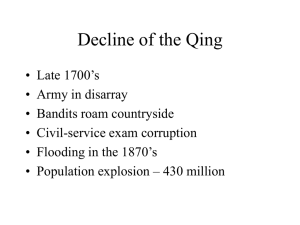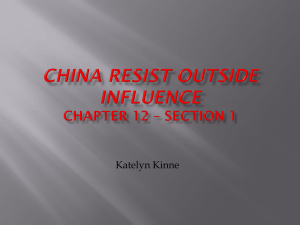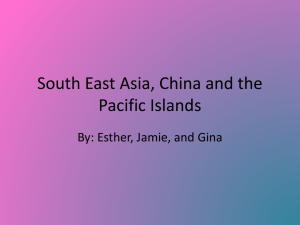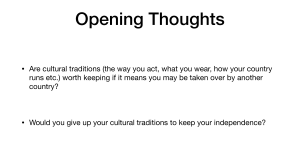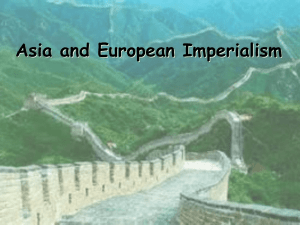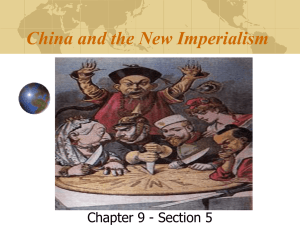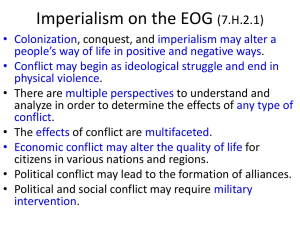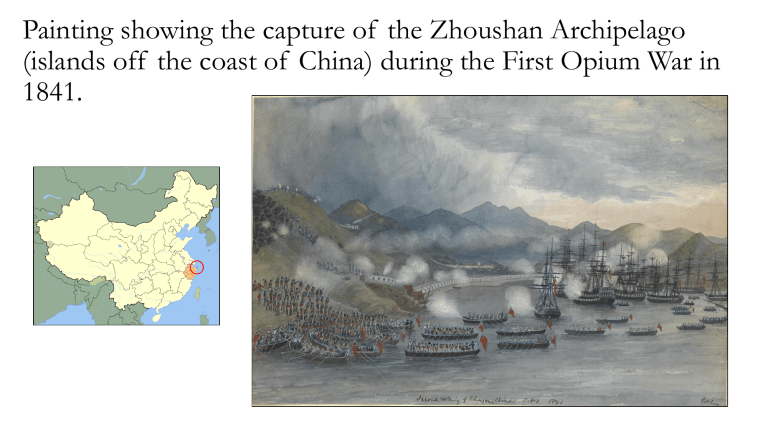
Painting showing the capture of the Zhoushan Archipelago (islands off the coast of China) during the First Opium War in 1841. Map showing China's loss of Outer Manchuria to Russia in the treaties of Aigun 1858 (beige) and Peking 1860 (red). Ruins of the Old Summer Palace, which was looted and destroyed by Anglo-French troops during the Second Opium War in 1860. Map showing areas of China embroiled in the Taiping Rebellion (light green) between 1850 and 1864. The Taiping Rebellion, was a massive rebellion or civil war that was waged in China for fourteen years between the ruling Manchu (foreign) Qing dynasty and people who are Han (native) Chinese. The uprising was commanded by Hong Xiuquan, an ethnic Hakka (a Han subgroup) and the selfproclaimed brother of Jesus Christ. Its goals were religious, nationalist, and political in nature; Hong sought the conversion of the Han people to the Taiping's syncretic version of Christianity and to overthrow the Manchu-led Qing Dynasty. The Qing Dynasty survived the rebellion, but it was left severely weakened. It ranks as one of the bloodiest wars in human history, the bloodiest civil war, and the largest conflict of the 19th century. In terms of deaths, the civil war is comparable to World War I. 30 million people fled the conquered regions to foreign settlements or other parts of China. The war featured extreme brutality on both sides. A drawing of Hong Xiuquan, dated from around 1860. French troops capture a Chinese fort at the Battle of Nui Bop during the Sino-French War, 1885. The Situation in the Far East image. Its creator (Tse Tsan-tai, 1872-1939) depicted the western powers encroaching on China at the end of the nineteenth century in symbolic form. The bear representing Russia is intruding from the north, the bulldog head with a lion body representing the United Kingdom is in south China, with its tail around the Shantung peninsula, the Gallic frog is in southeast Asia, with an inscription "Fashoda", in reference to Fashoda Incident opposing Britain and France in Africa. The frog has the Hainan Island in its right hand, in reference to Guangzhouwan, and part of the Sichuan in its left hand. The bald eagle representing the United States is approaching from the Philippines. (The U.S. had already invaded the Philippines at this time.) On the eagle is written "Blood is thicker than water," a reference to U.S. Navy Commodore Josiah Tattnall's saying in 1859. The symbolic Sun behind Japan spreads its rays across Korea onto China, while Japan fishes for Taiwan. Some other European countries, following Prussia, are waiting to invade China at the bottom of the map. Chinese generals in Pyongyang surrender to the Japanese during the First Sino-Japanese War, October 1894. A political cartoon by artist W. A. Rogers. Harper’s Weekly, 1899. The bottom reads “A Fair Field and No Favor” and Uncle Sam says, I’m out for commerce, not conquest!” By the end of the 19th century, European powers and Japan had begun to carve China into their own spheres of interest. In 1899, fearing the United States would be shut out from expanding their trade opportunities, U.S. Secretary of State John Hay urged that all nations be given equal trading and commercial access to China. This became known as the "Open Door" policy. Though U.S. correspondence regarding such a policy was transmitted to the other nations, China was not officially notified of this position. Political cartoon that appeared in Judge, a satirical American magazine, ca. 1902. Uncle Sam is carrying a variety of modern innovations, including farm equipment, steel rails for the construction of railroads and bridges, a sewing machine, and a book labeled with the words “education” and “religion.” The signs in China say “Wanted,” and list items like stoves, medicines, disinfectant, lamps, petroleum, sewing machines, bridges, and asphalt roads. Soldiers of the Eight-Nation Alliance in the Forbidden City after the defeat of the Boxer Rebellion, 1901. The Eight-Nation Alliance was a multinational military coalition that invaded northern China in 1900 with the stated aim of relieving the foreign diplomats in Beijing, who were besieged by the popular Boxer militia. The Boxers were attempting to eradicate foreigners from China. The Allied forces consisted of approximately 45,000 troops from the eight nations of Germany, Japan, Russia, Britain, France, the United States, Italy, and Austria-Hungary. Photograph of two men reclining on couches at an opium house in China, 1902. Protestors dissatisfied with the Treaty of Versailles for China, gathered in Tiananmen Square in Beijing, 1919. Around 3,000 students from 13 universities in Beijing gathered there to oppose Article 156 of the Treaty of Versailles which provided for the handover of a German possession in China to Japan. This officially sparked the May Fourth Movement. The May Fourth Movement was a Chinese anti-imperialist, cultural, and political movement which grew out of student protests in Beijing on 4 May 1919. A mass grave of victims of the Nanjing Massacre on the shore of the Qinhuai River, 1937. The Rape of Nanjing or Massacre at Nanjing was an episode of mass murder and mass rape committed by Imperial Japanese troops against the residents of Nanjing (Nanking), at that time the capital of China, during the Second SinoJapanese War (1937–1945). The massacre occurred over a period of six weeks. Approximately 300,000 Chinese citizens were killed. Edward L. Dreyer, historian specializing in Chinese history, in a paper published in 2007. "China's nineteenth-century humiliations were strongly related to her weakness and failure at sea. At the start of the First Opium War, China had no unified navy and not a sense of how vulnerable she was to attack from the sea. British navy forces sailed and steamed wherever they wanted to go. In the Arrow War (1856–60), the Chinese had no way to prevent the Anglo-French navy expedition of 1860 from sailing into the Gulf of Zhili and landing as near as possible to Beijing… The defeat at sea, and the resulting threat to steamship traffic to Taiwan, forced China to conclude peace on unfavorable terms."
